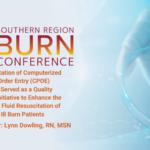Abstract | December 20, 2021
How Implementation of Computerized Physician Order Entry (CPOE) Technology Served as a Quality Improvement Initiative to Enhance the Nurse’s Role in Fluid Resuscitation of Critically Ill Burn Patients
Learning Objectives
- To identify and describe how a protocol was developed post-CPOE implementation to address gaps in nursing care during fluid resuscitation of critically ill burn patients.
- To discuss future research being developed to evaluate the effectiveness of this QI initiative.
Introduction:
The migration of paper medical records to electronic health record (EHR) has been in process for a few years now and most facilities have achieved this successfully. EHR has streamlined care and documentation. Further developments such as Computerized Physician Order Entry (CPOE) has been noted as one of the most promising functionalities of Health Information Technology, as it allows providers to enter orders, medications, diagnostic tests, and procedures, with the intent of improving the clarity and specificity of physician orders, facilitating the rapid communication of orders to pharmacies, and providing significantly enhanced decision support capabilities compared to traditional handwritten orders.1 Initiation of CPOE has been beneficial in many ways, particularly in decreasing medication errors related to handwritten orders. In the clinical scenario of acute resuscitation of a critically injured burn patient, the CPOE structure did not address every need that would arise, especially if fluid titration were necessary. Nursing staff were left unsure of what to do in terms of their role in adjusting fluids and assessing for adequacy of resuscitation. This led to gaps in care in which potential critical situations needed to be addressed. For instance, the possible development of abdominal compartment syndrome and how to respond to it was not part of CPOE set that was implemented. This was placing the patient at risk by delaying initiation of hemodynamic monitoring and delaying fluid and electrolyte replacement.
Methods:
Our response was to create a nurse-drive protocol that provided direction in areas that were noted to be weak or in which the nurses demonstrated lack of understanding in prioritizing tasks and care. For instance, identifying abdominal compartment syndrome earlier and following a specific protocol where there was none. Other issues that were problematic with CPOE were timing and administration of fluid boluses, tracking these boluses, identifying responsiveness to crystalloid versus the need to initiate colloid, as well as electrolyte replacement.
Results:
The nurse-driven protocol for fluid resuscitation provides built-in triggers that prompt input by the nurse without having to phone a physician and wait on orders. The protocol directly provides guidelines to critical timing of interventions related to patient response during resuscitation. Data is currently being collected over a 5-year period to assess adequacy of resuscitation before and after implementation of this initiative with specific focus being made on organ failure and hemodynamics in the acute phase of resuscitation.
Conclusions:
CPOE technology left gaps in nursing care during fluid resuscitation of acute burn patients. A nurse-driven protocol addressed these gaps to help improve patient trends and response during critical timepoints. Data being collected currently should reflect the improved patient outcomes we have appreciated anecdotally.

